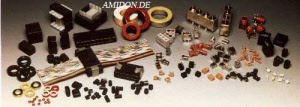Q-Kurven
Lager- und Betriebstemperatur
Ferritkerne sind sehr robust in Bezug auf die Temperatur, sie können nicht "physikalisch" geändert werden, außer die Temperatur steigt über 1000ºC, sie können jedoch bei schnellen Temperaturänderungen (> 1ºC / Sek.) Reißen: "Thermal Shock". Die Curietemperatur ist eine materialspezifische Eigenschaft, oberhalb derer der Ferrit seine magnetischen Eigenschaften verliert, sobald die Temperatur wieder unter Curie absinkt, kehren die magnetischen Eigenschaften zurück.
1.) Für Entstörungsbauteile, die keine Kunststoffgehäuse, -beschichtungen oder -leiter haben:
Lagertemperatur: -55º bis + 125ºC
Betriebstemperatur: -55º bis + 125ºC. Die Leistung wird normalerweise durch die materialspezifischen Impedanz- und Temperaturkurven herabgesetzt.
2.) Für Suppression Komponenten mit Kunststoff Fällen zugeordnet
Lagertemperatur: 0º bis + 85ºC
Betriebstemperatur: 0º bis + 85ºC Die Leistung wird normalerweise durch die materialspezifischen Impedanz- und Temperaturkurven herabgesetzt. Die Einschränkung besteht in den Kunststoffkoffern, oberhalb von + 85ºC erweicht der Kunststoff und kann sich unter 0ºC verformen. Der Kunststoff kann spröde werden und reißen, wenn er geöffnet und geschlossen wird.
3.) Für Entstörkomponenten mit Schutzlacken
Lagertemperatur: -55º bis + 90ºC
Betriebstemperatur: -55 ° bis + 90 ° C Die Leistung wird normalerweise gemäß den materialspezifischen Impedanz- und Temperaturkurven herabgesetzt. Bei thermofixierter Kunststoffbeschichtung (grün oder weiß) über + 105 ° C erweicht die Beschichtung und kann klebrig werden. Für die Parylene-Beschichtung (transparent) liegt der empfohlene Betriebstemperaturbereich zwischen -55º und + 90ºC
4.) Für Suppressionskomponenten mit Leitern:
Lagertemperatur: -55º bis + 125ºC, RH <55%, empfohlene Haltbarkeitsdauer ist ein Jahr, Lötbarkeit sollte für längere Zeit ausgewertet werden.
Ferrites cores are very robust when it comes to temperature, they cannot “physically” be changed unless the temperature goes above 1000ºC, they however can crack with fast temperature changes ( > 1ºC/sec.) : “Thermal Shock”. Curie temperature is a material specific characteristic, above which the ferrite loses its magnetic properties, once the temperature returns to below Curie the magnetic properties return.
1.) For Suppression components that do not have plastic cases, coatings or conductors :
Storage Temperature : -55º to +125ºC
Operating Temperature: -55º to +125ºC. performance typically derates per the material specific Impedance vs. Temperature curves.
2.) For Suppression components associated with plastic cases
Storage Temperature : 0º to +85ºC
Operating Temperature: 0º to +85ºC performance typically derates per the material specific Impedance vs. Temperature curves. The constraint is the plastic cases, above +85ºC the plastic softens and can deform, below 0ºC. the plastic can become brittle and crack when opened and closed.
3.) For Suppression components with conformal coatings
Storage Temperature : -55º to +90ºC
Operating Temperature: -55º to +90ºC performance typically derates per the material specific Impedance vs. Temperature curves. For thermo-set plastic coating (green or white) above +105ºC the coating softens and can becomes tacky. For Parylene coating (transparent) the suggested operating temperature range is -55º to +90ºC
4.) For Suppression components with conductors :
Storage Temperature : -55º to +125ºC, RH < 55%, suggested shelf life is one year, solderability should be evaluated for longer periods
